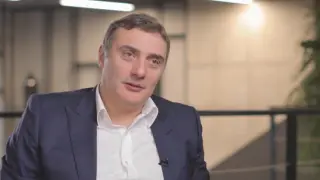Shota Berekashvili: “The economy has doubled in four years.”
Verdict: FactCheck concludes that Shota Berekashvili’s statement is MOSTLY FALSE.
Georgia’s economy totalled GEL 49.8 billion in 2020 and reached GEL 91.9 billion in 2024, reflecting an 85% rise. However, an 85% increase is not equivalent to doubling. Furthermore, this figure itself has two key issues that Shota Berekashvili did not address: the impact of the pandemic and inflation.
Georgia’s economy grew by 10.6% in 2021 as compared to 2020 but only by 3.6% relative to 2019. The post-pandemic recovery, driven by the reopening of businesses resulted in the highest economic growth rates of the decade in 2021 – not just in Georgia but globally, in most economies.
Nominal growth alone does not accurately represent reality. It is essential to evaluate growth in the production and consumption of goods and services rather than merely tracking the increase in the GDP measured in GEL or even USD. Moreover, the reporting period was characterised not only by high economic growth but also by significant inflation. Consumer prices increased by 27.1% between 2021 and 2024. The economy grew not by 85% (from GEL 49.8 billion to GEL 91.9 billion) but by 45% (from GEL 46.6 billion to GEL 67.5 billion) when adjusted for inflation, using 2019 constant prices.[1] Real economic growth in 2024 amounted to just 36% (from GEL 49.7 billion to GEL 67.5 billion) relative to 2019.
Whilst GDP growth is accompanied by an expansion in revenue, it remains unclear how inclusive this growth was or how evenly it was distributed amongst citizens. No publicly available research or reference addresses the aforementioned issue. Therefore, it is unknown what source the author of the statement relied on. FactCheck cannot evaluate this part of the claim and has excluded it from its verdict due to the lack of citation.
The core claim concerns economic growth. Whilst the nominal economy grew by 85% between 2020 and 2024 – not 100% – real growth was only 45%, after accounting for inflation. Furthermore, the base-year effect played a significant role even within this 45% – without it, cumulative real growth from 2019 to 2024 would be 36%. Considering all the above, FactCheck concludes that Shota Berekashvili’s statement is MOSTLY FALSE.
Analysis
When discussing Georgia’s economy, member of the Georgian Dream, Shota Berekashvili, stated: “The economy has doubled in just four years. This growth has been inclusive, positively impacting the incomes of our citizens.”
Georgia’s nominal economy did not double but grew by 85% between 2021 and 2024, rising from GEL 49.8 billion to GEL 91.9 billion. However, this figure has two major issues: the impact of the pandemic and inflation. The former provided a boost unrelated to economic reforms, whilst the latter shows that real growth was roughly half of the nominal increase.
The GDP contracted by 6.3% in 2020 due to the pandemic and COVID-19 restrictions, reflecting the steepest decline since the early 1990s. This drop was not driven by a deterioration of fundamental economic factors; rather, businesses were shut down by government decree and their subsequent reopening in 2021 became the primary driver of GDP growth the following year. As a result, whilst the economy grew by 10.6% in 2021 as compared to 2020, the increase relative to 2019 was only 3.6%.
The relatively high economic growth rate (11% in 2022, 7.8% in 2023 and 9.4% in 2024) continued in the following years, influenced in part by the effects of the Russia-Ukraine war. Remittances from Russia surged by 400% in 2022. Meanwhile, the re-export of passenger cars to Kazakhstan and Kyrgyzstan increased substantially in 2023-2024. Notably, Kyrgyzstan became the country’s top export destination in 2024, despite not even being amongst Georgia’s ten largest export partners before the war. Whilst FactCheck cannot decisively confirm whether passenger cars imported from Georgia are transited to Russia, the scale of re-exports raises reasonable concerns.[2]
It is impossible to predict when the war will end, how long the sanctions on Russia will remain in place or whether re-exports to Central Asian countries will continue post-war. There are risks that if sanctions on Russia are lifted and traditional patterns of auto exports and other economic activities resume fully or partially, the economic growth rate may decline.
Georgia’s nominal economy grew by 85% between 2021 and 2024, driven by the post-pandemic period, the Russia-Ukraine war or other external factors. However, this was not a true 85% real growth, as consumer prices rose by 27% during the same period, suggesting that inflation significantly reduced the actual increase in the economy.
An increase in income from GEL 100 to GEL 200 does not necessarily mean a person has become twice as wealthy. What truly matters is the amount of goods and services that could be purchased with GEL 100 in the first year as compared to GEL 200 in the following. The same principle applies to a country’s overall economy. For example, if a country continues to produce 100 loaves of bread but the price of each loaf rises from GEL 1 to GEL 1.5, the nominal economy will have growth by 50% whilst the real economy remains unchanged. In theory, a country’s GDP in domestic currency can increase dramatically during periods of hyperinflation, even as the real economy contracts. Despite a 6.3% economic decline in 2020, Georgia’s nominal GDP still experienced a slight increase, rising from GEL 49.7 billion to GEL 49.8 billion.
Consumer prices rose by 9.6% in 2021, marking the highest inflation rate since 2008. Inflation reached 11.9% in 2022, setting a record for the 21st century. However, subsequently, price growth slowed significantly, declining to 2.5% in 2023 and further to 1.1% in 2024.
Georgia’s economy grew from GEL 46.6 billion to GEL 65.7 billion when measured in constant 2019 prices. This suggests that real growth constituted 45% – lower than the nominal 85% rise.
Graph 1: GDP (GEL Billion)
Source: National Statistics Office of Georgia
Real economic growth can also be calculated by multiplying the annual GDP growth rates in the long term. Georgia’s economy expanded by 10.6% in 2021, 11% in 2022, 7.8% in 2023 and 9.4% in 2024, based on preliminary data. As a result, the real economy grew by 45% over four years (100*1.106*1.11*1.078*1.094=145).
An average annual growth rate of 19% would have been required for the economy to double in four years, which is unrealistic. Furthermore, the required average annual growth would have been 16.5% for an 85% increase (if nominal growth was equivalent to real growth). In reality, the average annual growth constituted 9.6% which is quite high but still significantly below both the 19% and 16.5% figures. If we exclude the post-pandemic effect, the economy grew by 46% as compared to 2019 and the average annual growth rate drops to 6.3% in this case.
Shota Berekashvili also mentioned inclusive growth. Indeed, employee salaries and pensions have increased and unemployment has decreased since 2020. Meanwhile, the number of social assistance programme beneficiaries and migrants also rose. Although income growth naturally accompanies economic growth, the extent to which this growth was inclusive and how evenly it impacted the population remains unclear. Therefore, this aspect of the statement did not influence the concluding verdict.
The core claim concerns economic growth. Whilst the nominal economy grew by 85% between 2020 and 2024 – not 100% – real growth was only 45%, after accounting for inflation. Furthermore, the base-year effect played a significant role even within this 45% – without it, cumulative real growth from 2019 to 2024 would be 36%. Considering all the above, FactCheck concludes that Shota Berekashvili’s statement is MOSTLY FALSE.
[1] GeoStat calculates the real GDP in 2019 constant prices.







